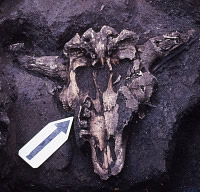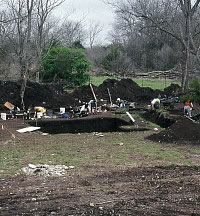Mustang Branch Site
Native peoples camped at the Mustang Branch site in east-central Hays County many times from the 7th to 16th centuries A.D. to bake plants and butcher and further process deer, antelope, and bison. The site sits on an ecotone or transitional area between the Edwards Plateau and the Blackland Prairie, providing easy access to diverse resources from the two ecosystems. Bison and antelope would have been attracted to the tall grass prairie, while deer were abundant on the Plateau. From the end of the Late Archaic through the Toyah periods, all three animals were hunted near the site and those who stayed at the site extracted the valuable marrow from the bones of the animals and turned hides into finished leather products.
The Mustang Branch site (41HY209) was investigated in 1989 by the Texas Archeological Research Laboratory in advance of the extension of FM 1626, about 2 miles west of Buda. Researchers led by Robert A. Ricklis and Michael B. Collins documented occupations dating to the Late Archaic and Late Prehistoric periods including a large burned rock midden and a bone bed containing over 13,000 bone fragments. The archeological deposits were subjected to an extensive analysis including geomorphic, pollen, and residue studies. Particular emphasis was placed on the determination of the horizontal distribution of cultural materials. The result of this multi-disciplinary approach was an extraordinarily detailed account of the events that took place at the site over a period of more than 900 years.
After initial testing of the site a distinction was made between the area of the site containing a large burned rock midden (HY209-M) and the area containing the terrace deposits (HY209-T). Both areas of the site contained archeological deposits dating from the latter part of the Late Archaic (ca. A.D. 600) through Austin and Toyah periods of the Late Prehistoric. Both areas contained a wide variety of artifacts including dart points, arrow points, and knives as well as large numbers of highly fragmented deer, antelope, and bison bones.
Evidence from the site indicates that the large burned rock midden was initially formed as a buildup of cooking debris during the Late Archaic and continued to grow as a result of repeated use through the Toyah period. Broken and burned deer and bison bone was present throughout the midden, suggesting that the prehistoric occupants of the site were smashing bones and boiling them to extract grease (fat). Similar evidence was found in the Toyah bone bed at the terrace area of the site.
The chipped stone assemblage at Mustang Branch reflects changing technology and lifeways in Central Texas over an approximately 1000-year span covering the last part of the Late Archaic and the entire Late Prehistoric. The introduction of the bow-and-arrow to the area ca. A.D. 700 marks the transition from the Late Archaic to the Late Prehistoric and is discernible in the archaeological record from Mustang Branch by the appearance of Scallorn arrow points in strata overlying deposits containing Darl dart points. The adoption of the �Toyah toolkit� of Perdiz arrow points, hide scrapers and beveled knives is believed to reflect regional increases in bison populations after A.D. 1250. At Mustang Branch, each of the aforementioned components of the Toyah toolkit are found overlying deposits containing Scallorn arrow points attributed to the Austin interval.
References:
Ricklis, Robert A. and Michael B. Collins
1994 Archaic and Late Prehistoric Human Ecology in the Middle Onion Creek Valley, Hays County, Texas. Studies in Archeology 19, Texas Archeological Research Laboratory, University of Texas at Austin.






